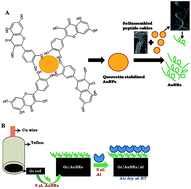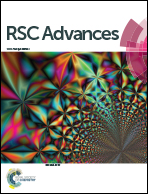A novel bioassay based gold nanoribbon biosensor to aid the preclinical evaluation of anticancer properties†
Abstract
In this work, we report a microbial biosensor fabricated for the preclinical assay of anticancer compounds. Gold nanoribbons were used as a transducer for mounting the microbe. For the synthesis of these unique Au nanostructures, quercetin stabilized gold nanoparticles (Q-AuNPs) were synthesized as a first step using onion peel. Later, dityrosine peptide was used as a sacrificial template for the synthesis of the gold nanoribbons (AuNRs). The structural morphology of the as-synthesized Au nanomaterial was examined using UV spectroscopy, XRD, SEM and TEM. The AuNRs were found to be <10 nm in diameter, which provided a good biocompatible environment and effective protection for the immobilization of Agrobacterium tumefaciens (At), a causative agent of crown gall disease. At is reported to cause tumors in plants through a tumorigenic mechanism similar to that of humans. Inhibition of At indicates that the inhibitory compound being screened exhibits anticancer activity. Clitoria ternatea (Ct) is traditionally used to cure many diseases and is known to possess anticancer activity. Therefore, we have used a Ct flower extract in the preclinical study of its anticancer activity against At by fabricating a simple electrochemical sensor. We have employed electrochemical techniques such as CV and EIS for the characterization of the developed microbial biosensor. Moreover, the as-synthesized AuNRs behave as an ideal transducer and platform, thus improving the electrode surface area and providing good biocompatibility for the immobilization of At. In contrast to other immobilization techniques and biosensors that often require elaborate procedures, cross-linking agents and rigorous chemical reactions, At was directly adsorbed onto the electrode under optimum conditions without any mediators. The results show that the developed biosensor is useful in the pre-clinical analysis of anticancer properties. Indeed the study examines the use of electrochemistry, demonstrating the rapid response and high sensitivity of the proposed sensor in contrast to bioassay procedures. In conclusion, the experimental results indicate that the developed biosensor accentuates the excellent properties of the synthesized AuNRs, which promises to be a novel avenue in designing biosensors.



 Please wait while we load your content...
Please wait while we load your content...